
Photograph of Carol
Rak at the spinning wheel by Alyce Henson
Wool
 Lustrous, soft,
curly - all qualities I look for in fleece. I have been working with two
people over many years now, who produce high quality, handspinning fleece.
Dorothy Bohonik, with her flock of primarily Canadian Border Leicester
with some Border Leicester/Dorset cross and Cary Pesek, with her flock
of Border Leicesters, Romney and Lincoln. Both of these people work very
hard to maintain healthy, well fed animals, pasturing whenever weather
permits and feeding them in such a way that vegetable matter and seeds
don't make their way into the fiber. Dorothy coats her sheep, making the
coats herself. This not only keeps the fleece cleaner, but prevents sun-bleached
tips. Cary coats some of her colored sheep and does her own shearing.
The quality of fiber is reliant on access to high quality feed and good
clean pasture (clean, meaning there are no burdock, thistle or other plants
that could get entangled in the fleece!) Both of them skirt their fleece
well, separating the tags and course wool so what remains is high quality,
wonderful spinning fiber. All the wool used in these pieces come from
these two farms.
Lustrous, soft,
curly - all qualities I look for in fleece. I have been working with two
people over many years now, who produce high quality, handspinning fleece.
Dorothy Bohonik, with her flock of primarily Canadian Border Leicester
with some Border Leicester/Dorset cross and Cary Pesek, with her flock
of Border Leicesters, Romney and Lincoln. Both of these people work very
hard to maintain healthy, well fed animals, pasturing whenever weather
permits and feeding them in such a way that vegetable matter and seeds
don't make their way into the fiber. Dorothy coats her sheep, making the
coats herself. This not only keeps the fleece cleaner, but prevents sun-bleached
tips. Cary coats some of her colored sheep and does her own shearing.
The quality of fiber is reliant on access to high quality feed and good
clean pasture (clean, meaning there are no burdock, thistle or other plants
that could get entangled in the fleece!) Both of them skirt their fleece
well, separating the tags and course wool so what remains is high quality,
wonderful spinning fiber. All the wool used in these pieces come from
these two farms.
Mohair
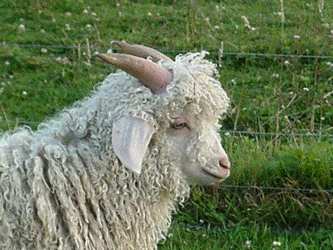 The
mohair, from angora goats, is kid and yearling, each with their own
unique qualities. These terms refer to the age of the goats when they
are clipped. Kid mohair is the first (at a few months old) and second
clip (six months after the first clip); yearling is six months after
that (the goat can be anywhere from 15 to 18 months. Kid is very soft
and fluffy, it can be compared, in texture, to angora rabbit fur (although
it contains grease before it is washed, which the rabbit fiber doesn't).
Yearling is still very soft but has already begun to develop a sheen
and more defined curls. I use each kind for very specific effects in
my work Sharon Reiland and her husband keep angora goats, as well as
sheep, llama and other animals on a small farm in Pleasantville, western
Pennsylvania. Sharon has been supplying me with high quality mohair
for many years now and selects her prime quality fiber for the work
that I do. She also runs a small store and studio, attached to their
home with spinning and weaving supplies, yarn made from the fibers they
produce from their own animals, as well as commercial yarn and woven
articles she makes there in her shoppe.
The
mohair, from angora goats, is kid and yearling, each with their own
unique qualities. These terms refer to the age of the goats when they
are clipped. Kid mohair is the first (at a few months old) and second
clip (six months after the first clip); yearling is six months after
that (the goat can be anywhere from 15 to 18 months. Kid is very soft
and fluffy, it can be compared, in texture, to angora rabbit fur (although
it contains grease before it is washed, which the rabbit fiber doesn't).
Yearling is still very soft but has already begun to develop a sheen
and more defined curls. I use each kind for very specific effects in
my work Sharon Reiland and her husband keep angora goats, as well as
sheep, llama and other animals on a small farm in Pleasantville, western
Pennsylvania. Sharon has been supplying me with high quality mohair
for many years now and selects her prime quality fiber for the work
that I do. She also runs a small store and studio, attached to their
home with spinning and weaving supplies, yarn made from the fibers they
produce from their own animals, as well as commercial yarn and woven
articles she makes there in her shoppe.
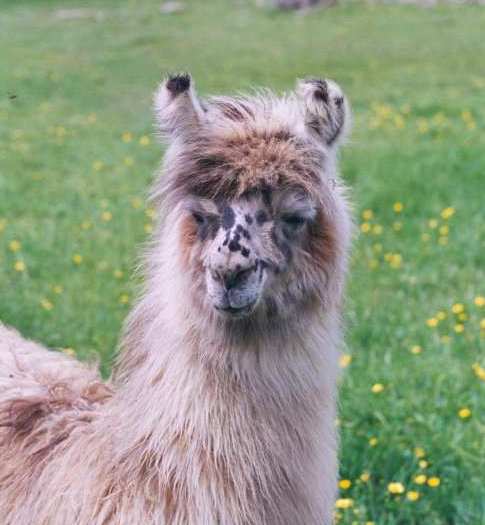
I
have several sources for llama and alpaca fiber, all in western PA.,
Sharon being one of them. These photos are from Sharon. Visit her site
from our Links page.
The
silk is imported from India. Tussah silk is one of the kinds of wild silk,
with a creamy gold luster. It adds a richness and glow the other fibers.
All the wild silks vary only in their color, being varying shades of cream
or gold. Silk moths are feed only on mulberry leaves. In captivity they
are fed consistently the same food Æ producing the white silk fiber indicative
of cultivated silk whereas in the wild there is more variation.
The
Process
When I bring the fleece home, in spring-time, I lay them out and check
there are no tags, or course wool that escaped the attention of those
who skirted. This having been done, I wash them, one fleece at a time,
with a mild dish detergent, to break down the lanolin (that's why dish
detergent), which can be quite dense.
After several washes and rinses in hot water I use the spin cycle on the
washer to remove excess water and then lay the clean fleeces outside to
dry in the fresh air. I wash the mohair in a similar fashion, although
using more washes as the grease is heavier. The fibers glisten in the
sun as they dry.
This
is all I need to do before spinning, when I am using the natural colors
of the fleece. If I need to dye some of the fiber I immerse them in the
dye bath while they are still wet, both wool and mohair.
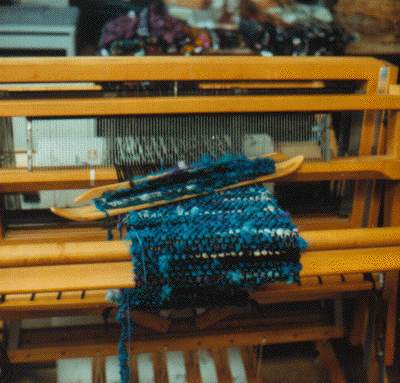
Photo by Alyce Henson
Spinning
There
are two methods I primarily use for the articles seen on the site; singles
and core and ply or novelty spinning. All the colored pieces are spun
core and ply, producing a light weight bulky yarn with mixed colors and
fibers. The natural, undyed fibers are spun in the same manner for some
of the pieces and in singles, as in the twill scarves. With core and ply,
I fluff fibers onto a strand of yarn attached to the bobbin (as seen in
the photo in "about us"). When I have filled a bobbin I ply
another fine yarn to "wrap" and secure the fibers onto the initial
core - then the yarn is ready to knit or weave.
Spinning
singles I use only the fiber itself, this is traditional spinning, to
form the yarn. I spin a "chunky" weight single, similar the
yarn used in Salish Indian sweaters, for the accessories in the photos.
Plyed yarn is combining two thinner singles, and reversing the twist to
ply them together.
I
give private lessons as well as workshops and presentations, teaching
and demonstrating the methods in each stem of the process, from fleece
in the grease to finished product. Contact me, either by phone or email,
for information.
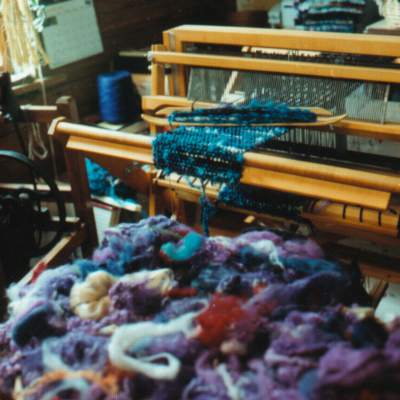
Photos courtesy of
Alyce Henson
Back
to top
![]()
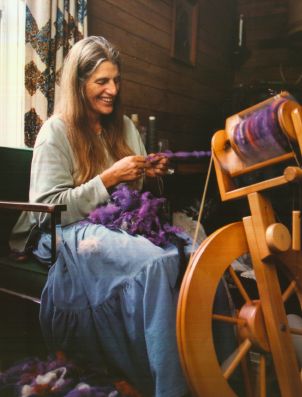

 Lustrous, soft,
curly - all qualities I look for in fleece. I have been working with two
people over many years now, who produce high quality, handspinning fleece.
Dorothy Bohonik, with her flock of primarily Canadian Border Leicester
with some Border Leicester/Dorset cross and Cary Pesek, with her flock
of Border Leicesters, Romney and Lincoln. Both of these people work very
hard to maintain healthy, well fed animals, pasturing whenever weather
permits and feeding them in such a way that vegetable matter and seeds
don't make their way into the fiber. Dorothy coats her sheep, making the
coats herself. This not only keeps the fleece cleaner, but prevents sun-bleached
tips. Cary coats some of her colored sheep and does her own shearing.
The quality of fiber is reliant on access to high quality feed and good
clean pasture (clean, meaning there are no burdock, thistle or other plants
that could get entangled in the fleece!) Both of them skirt their fleece
well, separating the tags and course wool so what remains is high quality,
wonderful spinning fiber. All the wool used in these pieces come from
these two farms.
Lustrous, soft,
curly - all qualities I look for in fleece. I have been working with two
people over many years now, who produce high quality, handspinning fleece.
Dorothy Bohonik, with her flock of primarily Canadian Border Leicester
with some Border Leicester/Dorset cross and Cary Pesek, with her flock
of Border Leicesters, Romney and Lincoln. Both of these people work very
hard to maintain healthy, well fed animals, pasturing whenever weather
permits and feeding them in such a way that vegetable matter and seeds
don't make their way into the fiber. Dorothy coats her sheep, making the
coats herself. This not only keeps the fleece cleaner, but prevents sun-bleached
tips. Cary coats some of her colored sheep and does her own shearing.
The quality of fiber is reliant on access to high quality feed and good
clean pasture (clean, meaning there are no burdock, thistle or other plants
that could get entangled in the fleece!) Both of them skirt their fleece
well, separating the tags and course wool so what remains is high quality,
wonderful spinning fiber. All the wool used in these pieces come from
these two farms.  The
mohair, from angora goats, is kid and yearling, each with their own
unique qualities. These terms refer to the age of the goats when they
are clipped. Kid mohair is the first (at a few months old) and second
clip (six months after the first clip); yearling is six months after
that (the goat can be anywhere from 15 to 18 months. Kid is very soft
and fluffy, it can be compared, in texture, to angora rabbit fur (although
it contains grease before it is washed, which the rabbit fiber doesn't).
Yearling is still very soft but has already begun to develop a sheen
and more defined curls. I use each kind for very specific effects in
my work Sharon Reiland and her husband keep angora goats, as well as
sheep, llama and other animals on a small farm in Pleasantville, western
Pennsylvania. Sharon has been supplying me with high quality mohair
for many years now and selects her prime quality fiber for the work
that I do. She also runs a small store and studio, attached to their
home with spinning and weaving supplies, yarn made from the fibers they
produce from their own animals, as well as commercial yarn and woven
articles she makes there in her shoppe.
The
mohair, from angora goats, is kid and yearling, each with their own
unique qualities. These terms refer to the age of the goats when they
are clipped. Kid mohair is the first (at a few months old) and second
clip (six months after the first clip); yearling is six months after
that (the goat can be anywhere from 15 to 18 months. Kid is very soft
and fluffy, it can be compared, in texture, to angora rabbit fur (although
it contains grease before it is washed, which the rabbit fiber doesn't).
Yearling is still very soft but has already begun to develop a sheen
and more defined curls. I use each kind for very specific effects in
my work Sharon Reiland and her husband keep angora goats, as well as
sheep, llama and other animals on a small farm in Pleasantville, western
Pennsylvania. Sharon has been supplying me with high quality mohair
for many years now and selects her prime quality fiber for the work
that I do. She also runs a small store and studio, attached to their
home with spinning and weaving supplies, yarn made from the fibers they
produce from their own animals, as well as commercial yarn and woven
articles she makes there in her shoppe.

